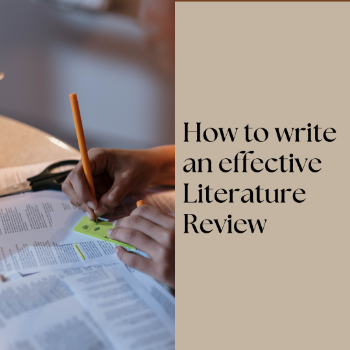Literature Review
A literature review is typically a written analysis that examines various publications related to a particular subject matter or theme.
Purpose of the Literature Review
- Providing contextual information about a research area.
- Underscoring the importance of the topic.
- Exhibiting familiarity with a specific issue.
- Paving the way for future research and positioning oneself within scholarly conversations.
Characteristics of literature review:
- Illuminates prominent research directions and patterns.
- Critically assesses the strengths and limitations of individual studies and the broader research landscape.
- Pinpoints areas where knowledge is lacking or incomplete.
- Articulates the imperative for current and/or forthcoming research endeavors.
The structure and arrangement of a literature review typically consist of the following sections:
Introduction or Overview:
- Provides a broad introduction to the topic, theme, or issue.
- Specifies the particular area of focus.
- Explains the methodology and rationale for source selection and exclusion, along with the organizational approach.
- Briefly outlines overarching trends in the scholarly literature on the subject.
- States the purpose behind conducting the review.
Body or Organizational Sub-divisions:
- Determines the most suitable organizational method.
- Summarizes sources by presenting pertinent information.
- Offers objective critiques and evaluations of the studies.
- Utilizes direct quotations judiciously and when appropriate.
The body of the literature review may be structured in several ways:
- Chronologically: Sequenced by publication date to depict the historical development of research.
- Methodologically: Grouped according to the research methods employed, offering insights into diverse research approaches.
- Thematically: Categorized based on concepts, trends, or themes, highlighting commonalities or patterns across sources.
- Ideologically: Organized around beliefs, ideologies, or schools of thought, showcasing varied perspectives within the literature.
Conclusion or Explanation of Significance:
- Summarizes key findings and underscores the importance of the reviewed literature.
- Identifies potential gaps or areas necessitating further investigation.
Strategies for Effective Literature Reviews
Strategy 1: Formulating Research Questions
Crafting precise and focused research questions lays the groundwork for a strong literature review. Start by identifying key concepts and refining them into specific questions that address distinct problems or issues.
Strategy 2: Comprehensive Searches
Thorough searches are crucial for incorporating relevant sources into the literature review. Identify appropriate databases and search engines, and develop a search strategy using keywords, synonyms, and advanced search features like Boolean operators.
Strategy 3: Screening and Selection
Screening and selecting articles efficiently helps manage the overwhelming volume of information. Utilize screening tools to assess relevance based on criteria such as direct relevance to the research question, robust methodology, and recent publication.
Strategy 4: Analysis and Synthesis
Analyse and synthesize gathered information by identifying key themes, summarizing findings, and utilizing reference management tools to organize and manage references.
Strategy 5: Critical Evaluation
Critically evaluate the literature to ensure its validity and reliability. Assess research methods and evidence for rigor and support, anchoring the literature review in credible and trustworthy sources.
Best Literature Review Tools for Researchers:
Semantic Scholar
This platform enables researchers to access and analyse scholarly literature, with a focus on leveraging AI and semantic analysis for enhanced insights.
Elicit
Elicit supports researchers in extracting, organizing, and synthesizing information from various sources, facilitating efficient data analysis.
Scite.Ai
Scite.AI helps determine the credibility and reliability of research articles, supporting evidence-based decision-making.
DistillerSR
DistillerSR streamlines and enhances the process of literature screening, study selection, and data extraction for researchers.
Rayyan
Facilitating efficient screening and selection of research outputs.
Consensus
It allows researchers to collaborate, annotate, and discuss research papers in real-time, fostering teamwork and knowledge sharing.
RAx
It assists researchers in performing efficient literature searches and analysis, aiding in identifying relevant articles and improving research quality.
Lateral
Lateral helps researchers discover relevant scientific articles and potential collaborators based on user interests and preferences.
Iris AI
Iris AI supports researchers in exploring and mapping existing literature, identifying knowledge gaps, and generating research questions.
Scholarcy
It extracts key information from research papers, aiding in comprehension and saving researchers time during analysis.
Research Rabbit
A research paper finding, management, and analysis tool that utilizes AI to search the web for relevant academic publications. It allows users to store articles and organize them in a library.
LitMaps
It facilitates the discovery of articles and papers for literature searches, generating a map of the most relevant articles associated with the seed paper.
Connected papers
A visual tool aids researchers in finding and exploring papers relevant to their field of work.
Soruces:
https://www.linkedin.com/pulse/top-5-strategies-conducting-effective-literature-kaytu-ma-onhiawoda
https://www.scijournal.org/articles/best-literature-review-tools-for-researchers
https://repairit.wondershare.com/online-file/ai-tools-for-literature-review.html


